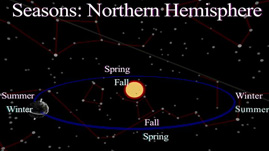Teachers' Domain - Digital Media for the Classroom and Professional Development
User: Preview



Animations and essays were created and written by Dr. Michael Gallis, the Pennsylvania State University.
Teachers who reviewed the collection were Patrick Callahan, Tara Clopper, and David R. McCachren. Instructional designer was Rucha Modak. Multimedia producer was Betsy Hutton. Director of Educational Services, Penn State Public Broadcasting is Dr. Babs Bengtson.

The changes of seasons have their origins in the apparent motion of the sun through the sky, although we often miss that connection because we rely upon technological means to track time rather than personal observations of the sky.
This video animation illustrates how the combination of the tilt of earth's spin axis and the orbit of the earth about the sun creates the geometry responsible for earth’s seasons. The earth’s spin axis keeps its direction, but as the earth moves around the sun, the axis tilt changes its direction relative to the sun.
The sun rises and the sun sets, and so marks the passage of days. The changes of seasons, with the sun high in the sky during summer and lurking closer to the horizon in winter, mark the passage of the year. These measures of time have their origins in the apparent motion of the sun through the sky, although we often miss that connection because we rely upon technological means to track time rather than personal observations of the sky.
The apparent daily motion of the sun is caused by the spinning of the earth on its axis. The motion of the stars over the course of the night also reflects this spinning motion and, over the centuries, the close alignment of earth’s spin axis with the star we call Polaris shows that the direction of this axis is steady. This axis is tilted (about 23.5º) from the axis of earth’s orbit about the sun.
The combination of the tilt of earth's spin axis and the orbit of the earth about the sun creates the geometry responsible for earth’s seasons. The earth’s spin axis keeps its direction, but as the earth moves around the sun the axis tilt changes its direction relative to the sun. At one part of the orbit the northern hemisphere receives more direct sunlight, has more sunlight hours in the course of a day and experiences the warming season of summer. Six months and half an orbit later, the northern hemisphere has less direct sunlight and fewer sunlight hours for the cooling season of winter. The southern hemisphere is tilted away from the sun when the northern hemisphere is tilted towards the sun and vice versa; thus, the two hemispheres always experience “opposite” seasons.
One naive idea that arises is that the elliptical shape of the earth’s orbit creates seasons, so that summer occurs when the earth is closest to the sun and winter occurs when earth is farthest from the sun. In reality, the earth’s orbit is very nearly circular so that the distance of the earth from the sun does not change enough to noticeably affect the seasonal variations in temperature. Furthermore, both hemispheres would have the same seasons at the same time, but the southern hemisphere actually experiences winter when the northern hemisphere experiences summer.
Because diagrams illustrating the cause of seasons do show the Sun and Earth to much larger than scale, these diagrams are often misinterpreted as implying that the “near” hemisphere of the tilted Earth is significantly closer than the far side to account for different temperatures for summer and winter. If the sun were scaled to the size of a basketball, the Earth would be the size of a peppercorn and Earth’s orbital distance from the Sun would be about 26 yards. Tilting the Earth/peppercorn will not bring one side significantly closer to the Sun. If we were to try to illustrate Earth in its orbit in a properly scaled illustration, the Earth would be too small to see!
To learn more about the daily motion of the sun in the sky, check out Observe Sunrise and Sunset.
To learn more about how seasons affect life on earth check out Global View of the Seasons.
To learn about Galileo and his evidence that the sun, not the earth, was the center of the solar system, check out Galileo: Sun-Centered System.
 Loading Standards
Loading Standards Teachers' Domain is proud to be a Pathways portal to the National Science Digital Library.
Teachers' Domain is proud to be a Pathways portal to the National Science Digital Library.
